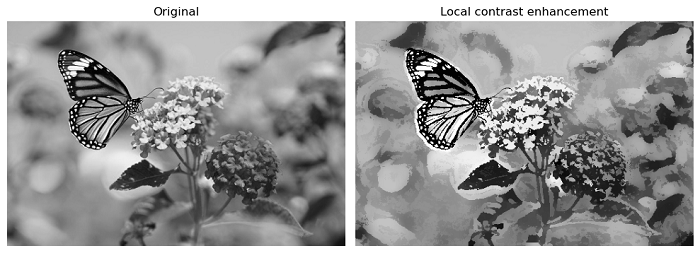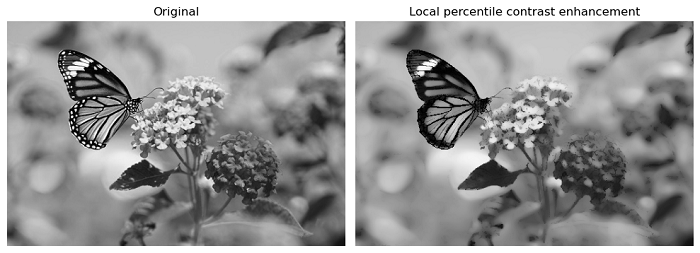
- Scikit Image – Introduction
- Scikit Image - Image Processing
- Scikit Image - Numpy Images
- Scikit Image - Image datatypes
- Scikit Image - Using Plugins
- Scikit Image - Image Handlings
- Scikit Image - Reading Images
- Scikit Image - Writing Images
- Scikit Image - Displaying Images
- Scikit Image - Image Collections
- Scikit Image - Image Stack
- Scikit Image - Multi Image
- Scikit Image - Data Visualization
- Scikit Image - Using Matplotlib
- Scikit Image - Using Ploty
- Scikit Image - Using Mayavi
- Scikit Image - Using Napari
- Scikit Image - Color Manipulation
- Scikit Image - Alpha Channel
- Scikit Image - Conversion b/w Color & Gray Values
- Scikit Image - Conversion b/w RGB & HSV
- Scikit Image - Conversion to CIE-LAB Color Space
- Scikit Image - Conversion from CIE-LAB Color Space
- Scikit Image - Conversion to luv Color Space
- Scikit Image - Conversion from luv Color Space
- Scikit Image - Image Inversion
- Scikit Image - Painting Images with Labels
- Scikit Image - Contrast & Exposure
- Scikit Image - Contrast
- Scikit Image - Contrast enhancement
- Scikit Image - Exposure
- Scikit Image - Histogram Matching
- Scikit Image - Histogram Equalization
- Scikit Image - Local Histogram Equalization
- Scikit Image - Tinting gray-scale images
- Scikit Image - Image Transformation
- Scikit Image - Scaling an image
- Scikit Image - Rotating an Image
- Scikit Image - Warping an Image
- Scikit Image - Affine Transform
- Scikit Image - Piecewise Affine Transform
- Scikit Image - ProjectiveTransform
- Scikit Image - EuclideanTransform
- Scikit Image - Radon Transform
- Scikit Image - Line Hough Transform
- Scikit Image - Probabilistic Hough Transform
- Scikit Image - Circular Hough Transforms
- Scikit Image - Elliptical Hough Transforms
- Scikit Image - Polynomial Transform
- Scikit Image - Image Pyramids
- Scikit Image - Pyramid Gaussian Transform
- Scikit Image - Pyramid Laplacian Transform
- Scikit Image - Swirl Transform
- Scikit Image - Morphological Operations
- Scikit Image - Erosion
- Scikit Image - Dilation
- Scikit Image - Black & White Tophat Morphologies
- Scikit Image - Convex Hull
- Scikit Image - Generating footprints
- Scikit Image - Isotopic Dilation & Erosion
- Scikit Image - Isotopic Closing & Opening of an Image
- Scikit Image - Skelitonizing an Image
- Scikit Image - Morphological Thinning
- Scikit Image - Masking an image
- Scikit Image - Area Closing & Opening of an Image
- Scikit Image - Diameter Closing & Opening of an Image
- Scikit Image - Morphological reconstruction of an Image
- Scikit Image - Finding local Maxima
- Scikit Image - Finding local Minima
- Scikit Image - Removing Small Holes from an Image
- Scikit Image - Removing Small Objects from an Image
- Scikit Image - Filters
- Scikit Image - Image Filters
- Scikit Image - Median Filter
- Scikit Image - Mean Filters
- Scikit Image - Morphological gray-level Filters
- Scikit Image - Gabor Filter
- Scikit Image - Gaussian Filter
- Scikit Image - Butterworth Filter
- Scikit Image - Frangi Filter
- Scikit Image - Hessian Filter
- Scikit Image - Meijering Neuriteness Filter
- Scikit Image - Sato Filter
- Scikit Image - Sobel Filter
- Scikit Image - Farid Filter
- Scikit Image - Scharr Filter
- Scikit Image - Unsharp Mask Filter
- Scikit Image - Roberts Cross Operator
- Scikit Image - Lapalace Operator
- Scikit Image - Window Functions With Images
- Scikit Image - Thresholding
- Scikit Image - Applying Threshold
- Scikit Image - Otsu Thresholding
- Scikit Image - Local thresholding
- Scikit Image - Hysteresis Thresholding
- Scikit Image - Li thresholding
- Scikit Image - Multi-Otsu Thresholding
- Scikit Image - Niblack and Sauvola Thresholding
- Scikit Image - Restoring Images
- Scikit Image - Rolling-ball Algorithm
- Scikit Image - Denoising an Image
- Scikit Image - Wavelet Denoising
- Scikit Image - Non-local means denoising for preserving textures
- Scikit Image - Calibrating Denoisers Using J-Invariance
- Scikit Image - Total Variation Denoising
- Scikit Image - Shift-invariant wavelet denoising
- Scikit Image - Image Deconvolution
- Scikit Image - Richardson-Lucy Deconvolution
- Scikit Image - Recover the original from a wrapped phase image
- Scikit Image - Image Inpainting
- Scikit Image - Registering Images
- Scikit Image - Image Registration
- Scikit Image - Masked Normalized Cross-Correlation
- Scikit Image - Registration using optical flow
- Scikit Image - Assemble images with simple image stitching
- Scikit Image - Registration using Polar and Log-Polar
- Scikit Image - Feature Detection
- Scikit Image - Dense DAISY Feature Description
- Scikit Image - Histogram of Oriented Gradients
- Scikit Image - Template Matching
- Scikit Image - CENSURE Feature Detector
- Scikit Image - BRIEF Binary Descriptor
- Scikit Image - SIFT Feature Detector and Descriptor Extractor
- Scikit Image - GLCM Texture Features
- Scikit Image - Shape Index
- Scikit Image - Sliding Window Histogram
- Scikit Image - Finding Contour
- Scikit Image - Texture Classification Using Local Binary Pattern
- Scikit Image - Texture Classification Using Multi-Block Local Binary Pattern
- Scikit Image - Active Contour Model
- Scikit Image - Canny Edge Detection
- Scikit Image - Marching Cubes
- Scikit Image - Foerstner Corner Detection
- Scikit Image - Harris Corner Detection
- Scikit Image - Extracting FAST Corners
- Scikit Image - Shi-Tomasi Corner Detection
- Scikit Image - Haar Like Feature Detection
- Scikit Image - Haar Feature detection of coordinates
- Scikit Image - Hessian matrix
- Scikit Image - ORB feature Detection
- Scikit Image - Additional Concepts
- Scikit Image - Render text onto an image
- Scikit Image - Face detection using a cascade classifier
- Scikit Image - Face classification using Haar-like feature descriptor
- Scikit Image - Visual image comparison
- Scikit Image - Exploring Region Properties With Pandas
Scikit Image - Contrast Enhancement
Contrast enhancement is an image processing technique used to improve the visibility and quality of an image. It involves increasing the difference between the various elements within an image, such as objects, shapes, edges, and textures, by adjusting the distribution of intensity values or colors.
It can be useful when an image has poor contrast, meaning that the range between the darkest and lightest regions is limited, resulting in a flat and less informative appearance.
This technique is widely used in fields such as medical imaging, computer vision, remote sensing, and photography to improve image quality and get better visual information.
Pythons scikit-image library provides the rank.enhance_contrast() and rank.enhance_contrast_percentile() methods in the filters module to apply the contrast enhancing technique to an image.
Using the skimage.filters.rank.enhance_contrast() method
The rank.enhance_contrast() function is used to enhance the contrast of an image by replacing each pixel with either the local maximum or the local minimum value, depending on which one is closer to the pixel's gray value within a local maximum or local minimum.
Syntax
Following is the syntax of this method −
skimage.filters.rank.enhance_contrast(image, footprint, out=None, mask=None, shift_x=False, shift_y=False, shift_z=False)
Parameters
- image: This parameter represents the input image that you want to enhance contrast for.
- footprint: It defines the local neighborhood where the operation is applied. It is represented as a binary ndarray of 1's and 0's.
- out: If set to None, a new array is allocated for the result. The output array has the same data type as the input image.
- mask (optional): This is an ndarray that can be used to mask the area of the image included in the local neighborhood. Pixels with values greater than 0 in the mask are included and the rest are excluded. If not specified (default is None), the entire image is used.
- shift_x, shift_y, shift_z: These parameters specify the offset added to the center point of the footprint. The shift is bounded to the footprint sizes, meaning that the center must be inside the given footprint.
Return Value
It returns an output ndarray of the same shape and data type as the input image, containing the enhanced contrast image.
Example
The following example demonstrates how to enhance the contrast of a grayscale image using the enhance_contrast() function.
from skimage import io
from skimage.morphology import disk
from skimage.filters.rank import enhance_contrast
from skimage import img_as_ubyte
import matplotlib.pyplot as plt
# Load an example grayscale image
image = io.imread('Images/butterfly.jpg', as_gray=True)
noisy_image = img_as_ubyte(image)
# Apply the enhance_contrast() function to the image
penh = enhance_contrast(noisy_image, disk(5))
# Display the original and enhanced images side by side
fig, axes = plt.subplots(1, 2, figsize=(10, 10))
ax = axes.ravel()
ax[0].imshow(noisy_image, cmap=plt.cm.gray)
ax[0].set_title('Original')
ax[0].set_axis_off()
ax[1].imshow(penh, cmap=plt.cm.gray)
ax[1].set_title('Local contrast enhancement')
ax[1].set_axis_off()
plt.tight_layout()
plt.show()
Output
On executing the above program, you will get the following output −

Using the skimage.filters.rank.enhance_contrast_percentile() method
The rank.enhance_contrast_percentile() method is used to enhance the contrast of an image by replacing each pixel with either the local maximum or the local minimum value, depending on whether the pixel's gray value falls within a specified percentile interval [p0, p1].
Syntax
Following is the syntax of this method −
skimage.filters.rank.enhance_contrast_percentile(image, footprint, out=None, mask=None, shift_x=False, shift_y=False, p0=0, p1=1)
Parameters
- image: This parameter represents the input image that you want to enhance contrast for. It should be a 2-D NumPy array with data type uint8 or uint16.
- footprint: It defines the local neighborhood where the operation is applied. It is represented as a binary ndarray of 1's and 0's.
- out: If set to None, a new array is allocated for the result. The output array has the same data type as the input image.
- mask (optional): This is an ndarray that can be used to mask the area of the image included in the local neighborhood. Pixels with values greater than 0 in the mask are included and the rest are excluded. If not specified (default is None), the entire image is used.
- shift_x, shift_y, shift_z: These parameters specify the offset added to the center point of the footprint. The shift is bounded to the footprint sizes, meaning that the center must be inside the given footprint.
- p0 and p1: These parameters define the percentile interval [p0, p1] of the gray values to be considered when computing the local maximum and minimum values for contrast enhancement. The values of p0 and p1 should float in the range [0, 1].
Return Value
The function returns an output 2-D array of the same shape and data type as the input image, containing the enhanced contrast image.
Example
The below example demonstrates how to enhance the contrast of a grayscale image using the enhance_contrast_percentile() function.
from skimage import io
from skimage.morphology import disk
from skimage.filters.rank import enhance_contrast_percentile
from skimage import img_as_ubyte
import matplotlib.pyplot as plt
# Load an example grayscale image
image = io.imread('Images/butterfly.jpg', as_gray=True)
noisy_image = img_as_ubyte(image)
# Apply the enhance_contrast_percentile() function to the image
penh = enhance_contrast_percentile(noisy_image, disk(5), p0=0.1, p1=0.5)
# Display the original and enhanced images side by side
fig, axes = plt.subplots(1, 2, figsize=(10, 10))
ax = axes.ravel()
ax[0].imshow(noisy_image, cmap=plt.cm.gray)
ax[0].set_title('Original')
ax[0].set_axis_off()
ax[1].imshow(penh, cmap=plt.cm.gray)
ax[1].set_title('Local percentile contrast enhancement')
ax[1].set_axis_off()
plt.tight_layout()
plt.show()
Output
On executing the above program, you will get the following output −
